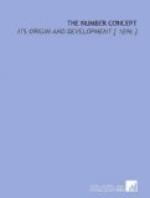One of the purest examples of quinary numeration is that furnished by the Betoya scale, already given in full in Chapter III., and briefly mentioned at the beginning of this chapter. In the simplicity and regularity of its construction it is so noteworthy that it is worth repeating, as the first of the long list of quinary systems given in the following pages. No further comment is needed on it than that already made in connection with its digital significance. As far as given by Dr. Brinton the scale is:
1. tey.
2. cayapa.
3. toazumba.
4. cajezea = 2 with plural
termination.
5. teente = hand.
6. teyente tey = hand 1.
7. teyente cayapa = hand 2.
8. teyente toazumba = hand 3.
9. teyente caesea = hand 4.
10. caya ente, or caya huena = 2 hands.
11. caya ente-tey = 2 hands 1.
15. toazumba-ente = 3 hands.
16. toazumba-ente-tey = 3 hands 1.
20. caesea ente = 4 hands.
A far more common method of progression is furnished by languages which interrupt the quinary formation at 10, and express that number by a single word. Any scale in which this takes place can, from this point onward, be quinary only in the subordinate sense to which allusion has just been made. Examples of this are furnished in a more or less perfect manner by nearly all so-called quinary-vigesimal and quinary-decimal scales. As fairly representing this phase of number-system structure, I have selected the first 20 numerals from the following languages:




